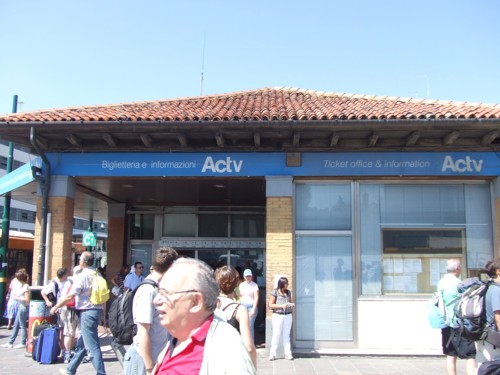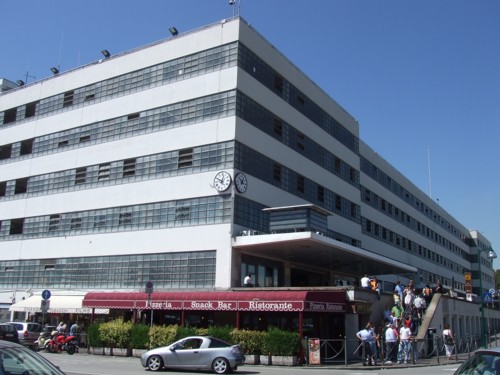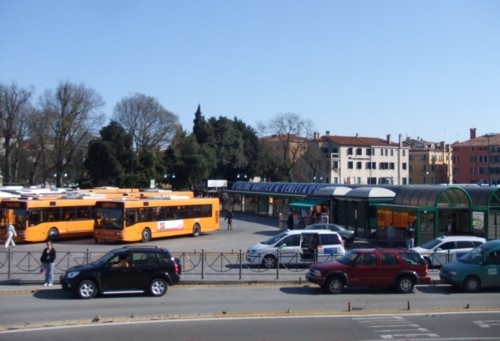If you are arriving in Venice by boat and you’re not planning any day trips, then you never need set eyes on the road traffic hub of Piazzale Roma. For most travellers, though, this big open square is a very significant Venetian landmark. If you are arriving by car or bus, this is the first part of Venice that you’ll see; the road from the mainland arrives and stops here. Piazzale Roma is an open-air bus station, with ferry stops alongside and car parks where drivers must leave their cars, should they have been foolhardy enough to bring a car to Venice.
Geography
The road from the mainland heads down a gentle slope and curves around to enter Piazzale Roma. On the right are the entrances to expensive multi-storey car parks; the main part of the square is filled with parking bays for public buses. The start of the Grand Canal is alongside Piazzale Roma, but is rather hidden by buildings: it’s to the left as you drive into the square, and is approached down a shallow flight of steps (with a ramp alongside). On this page we’ve added some useful views of the Piazzale, to help you get your bearings – hover over each photo with your cursor to read a description.
> Our plan of Piazzale Roma
First steps
If you’re just arriving in Venice, you should have planned in advance how you’ll reach your hotel or holiday apartment; Venice is a town which really benefits from some preparation. Your only options are foot or vaporetto (ferry); we really recommend you buy a map/guidebook before your holiday to get an idea of the town; if you haven’t bought one yet, this is the time to do it.
If you arrive during its opening times, the best place to visit on arrival is the tourist information office. This is housed in the white multi-storey car park; access it by climbing steps at the corner of the mainland road. Although there is sometimes a queue, the multi-lingual staff will be able to provide helpful advice and directions, as well as selling you a map, a travelcard or one of the city’s various tourist cards. Ask if you want ‘what’s on’ listings or additional leaflets – for example they stock a map of the northern lagoon which is useful if you’re exploring the islands.
Another useful office is across the road, between Piazzale Roma and the Grand Canal. This is the main information centre of ACTV, the company which runs the ferry services around Venice, as well as local mainland bus services. There are several kiosk windows on the exterior of the building; inside are more ticket desks where you can also purchase season tickets and tourist cards. You should buy vaporetto tickets before getting on a boat, so stock up in advance. Boat travel is expensive but worthwhile, and it will almost certainly be better to buy a season ticket -read our page about transport for more information and advice: Venice public transport.
Local buses
Local buses run by ACTV head across the road bridge to Mestre and the nearby mainland settlements. You can buy tickets at the ACTV kiosk (bus journeys are included in some travelcards, so check) and stamp them in the machine provided as you get on the bus. Buses stop at regular bays in the square; ask at the information kiosk if you can’t see where to catch your bus.

ATVO buses: exploring the Veneto
Most of the longer-distance services are run by a company called ATVO, who generally operate larger blue coaches. They have a ticket office in the base of the main white car-park building, opposite the bus stops. As with the ACTV services, you should buy your tickets in advance and stamp them or present them to the driver when boarding. Timetables are available in the office and online. ATVO run some useful routes for travellers; such as to the local seaside towns, to the two local airports and up to Cortina d’Ampezzo in the Dolomites.
Airport buses
ATVO run services to Treviso Airport and to Marco Polo Airport. As for other ATVO services you should buy tickets in advance at their ticket office. Buses (at the time of writing) depart from bus stop D2, which is the opposite side of the square from the Grand Canal. They generally stop here on arrival from the airports, although occasionally they park in more central bays. In either case, you can spot the white car park building behind you and either make your way there to visit the tourist information office, or cross the square, past the other bus stops, towards the ACTV kiosk and the Grand Canal. If you can’t get your bearings at all, ask the way to the Grand Canal (Canal Grande).
There are also local ACTV buses to Marco Polo Airport. These depart from the rows of ACTV bus stops closer to the Grand Canal. For more on airport transport see our airports page.
History and architecture
The railway bridge, opened under Austrian occupation in 1846, was Venice’s first physical connection with the mainland. In the 1930s a road bridge was constructed alongside, originally called Ponte del Littorio and opened by Mussolini. It was designed by Eugenio Miozzi (1889-1979), who also designed two bridges over the Grand Canal and the casino building on the Lido. The plans to bring motor vehicles to Venice were controversial, particularly since there are no roads within the city; Piazzale Roma is as far as one can drive. Nowadays the bridge is called the Ponte della Libertà, and a steady stream of buses, tourist coaches and cars crosses the lagoon into Venice. Occasionally the road is blocked by accidents and Venice is once more cut off, sometimes for hours. Commuters end up having to walk along the long bridge, or cram onto trains if the railway bridge is still open.
Take a moment to glance at the large white multi-storey car park building (autorimessa, called the Garage Comunale ASM); a significant work of architecture and much-praised in its time. When it opened in the 1930s it was the largest multi-storey car park in the world. It too was designed by Eugenio Miozzi.

Location
Piazzale Roma is at the western end of Venice on the southern side of the Grand Canal, in the district of Santa Croce. It is signposted quite frequently on this side of the Grand Canal. Almost all the vaporetto services stop here; the stop is simply called ‘Piazzale Roma’.
Hotels, businesses and services
There is a useful hotel right on Piazzale Roma, the Santa Chiara. It’s not the quietest or prettiest of locations but it does look over the Grand Canal and certainly takes away any hassle from an early or late arrival or departure. I once took some American visitors here in the early hours, after our flight was cancelled, and after knocking on the locked glass door a helpful night-receptionist appeared to find them rooms.
There is a Coop supermarket along the waterfront which is open seven days a week, and also a post office which has later postal collections (2pm) than most post boxes in Venice. Several bars and small restaurants dot the surroundings; including one eating place right by the steps to the car park.
On this site
Useful external links
Eugenio Miozzi archive (in Italian)
